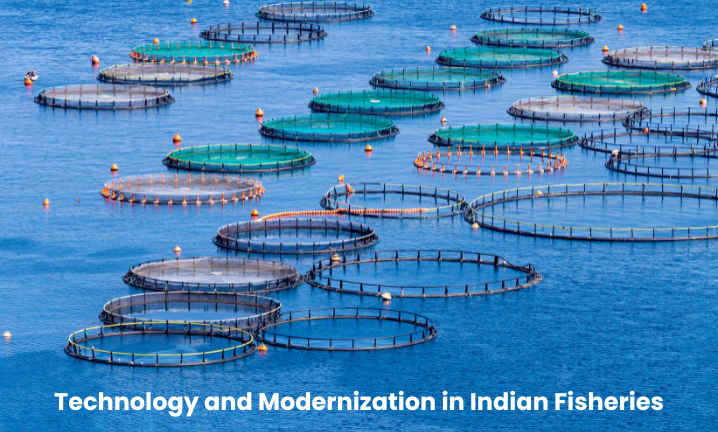
Technology and Modernization in Indian Fisheries: Balancing Tradition and Progress
The Indian fisheries sector plays a crucial role in the country's economy, contributing significantly to food security, employment, and foreign exchange earnings. With its extensive coastline of about 7,517 kilometers, numerous rivers, and abundant water resources, India is blessed with a diverse aquatic ecosystem that supports a wide variety of marine and freshwater species. Over the years, the fishing industry has witnessed a transformation, driven by technology and modernization. While these advancements have brought about numerous benefits, they have also raised concerns about sustainable practices and the preservation of traditional fishing communities. This article delves into the delicate balance between embracing technology and preserving traditions in Indian fisheries, and the efforts taken to ensure the sector's future viability.
Traditional Fishing Practices: The Heritage of Generations
Indian fisheries have a rich cultural heritage that is deeply intertwined with traditional fishing practices. For generations, fishing communities have relied on artisanal and small-scale fishing techniques, using simple fishing gear like nets, hooks, and traps. These practices were closely aligned with the local ecosystems, emphasizing sustainable harvesting and minimal environmental impact. The knowledge and skills passed down through generations have formed the backbone of the country's fishing traditions.
Advancements in Technology: Revolutionizing the Fishing Industry
With increasing demand for seafood and challenges posed by overfishing, climate change, and population growth, modernization became essential for the fishing industry to meet these demands sustainably. The adoption of advanced technologies has significantly enhanced the efficiency and productivity of Indian fisheries.
1. Mechanized Boats and Fishing Vessels: Traditional wooden boats have gradually been replaced by mechanized boats and trawlers. These modern vessels are equipped with powerful engines and advanced navigation systems, allowing fishermen to venture farther into the sea and access previously untapped fishing grounds.
2. Sonar and GPS: Sonar technology and GPS systems have revolutionized fishing practices by enabling fishermen to locate schools of fish with precision. This has significantly reduced search times and improved catch rates, leading to better returns on investment.
3. Fish Finding Technology: Fish finders and echo sounders have become indispensable tools in the fishing industry. These devices use sonar to detect fish underwater, helping fishermen identify potential catch locations and optimize their efforts.
4. Satellite Communication: Satellite communication has enabled real-time communication between fishing vessels and onshore stakeholders. This facilitates efficient logistics management, weather updates, and emergency support.
5. Refrigeration and Cold Storage: Onboard refrigeration and cold storage facilities have extended the shelf life of fish caught, allowing fishermen to preserve their catch and access distant markets.
6. Aquaculture and Hatcheries: Aquaculture and fish hatcheries have gained prominence in meeting the growing demand for fish and seafood. Controlled breeding and rearing of aquatic species have increased yields and reduced pressure on wild fish stocks.
Challenges and Concerns
While technology has undoubtedly enhanced the fishing industry, it has also brought forth some challenges and concerns:
1. Overfishing and Environmental Impact: Unregulated and excessive fishing can deplete fish stocks and disrupt marine ecosystems, impacting the balance of aquatic life.
2. Loss of Traditional Knowledge: The rapid adoption of modern techniques can lead to the erosion of traditional knowledge and cultural practices, which have sustained fishing communities for centuries.
3. Technological Divide: Access to advanced technology and training may be limited for small-scale fishermen and marginalized communities, exacerbating economic disparities.
4. Bycatch and Non-Target Species: Modern fishing methods sometimes result in unintended catches of non-target species, leading to wastage and potential threats to marine biodiversity.
5. Coastal Erosion and Pollution: Increased human activity associated with modern fishing practices can lead to coastal erosion and pollution, affecting both marine habitats and coastal communities.
Balancing Tradition and Progress
Achieving a delicate balance between tradition and progress is vital for the sustainable development of Indian fisheries:
1. Responsible Fishing Practices: Encouraging responsible fishing practices, such as size limits, seasonal bans, and gear regulations, can help ensure the conservation of fish stocks and protect ecosystems.
2. Integration of Traditional Knowledge: Recognizing and incorporating traditional knowledge into modern fishing practices can lead to innovative and sustainable solutions.
3. Community-Based Management: Involving local fishing communities in decision-making and management of resources fosters a sense of ownership and accountability for sustainable practices.
4. Capacity Building: Providing training and access to technology for small-scale fishermen can enhance their efficiency and economic prospects while minimizing environmental impact.
5. Government Policies and Incentives: Implementing policies that promote sustainable fishing practices and offering incentives for adopting eco-friendly technologies can drive positive change in the industry.
Technology and modernization have undoubtedly revolutionized the Indian fisheries sector, enabling increased productivity and economic growth. However, finding the right balance between embracing progress and preserving the rich traditions and cultural heritage of fishing communities is essential for a sustainable future. By adopting responsible practices, integrating traditional knowledge, and empowering local communities, India can ensure that its fisheries sector thrives while safeguarding the precious marine ecosystems for generations to come.




2 Comments
Philip W
Posted October 7, 2018 ReplyPhasellus hendrerit. Pellentesque aliquet nibh nec urna. In nisi neque, aliquet vel, dapibus id, mattis vel, nisi. Sed pretium, ligula sollicitudin laoreet viverra, tortor libero sodales leo, eget blandit nunc tortor eu nibh. Nullam mollis. Ut justo. Suspendisse potenti.
Philip W
Posted October 7, 2018 ReplyPhasellus hendrerit. Pellentesque aliquet nibh nec urna. In nisi neque, aliquet vel, dapibus id, mattis vel, nisi. Sed pretium, ligula sollicitudin laoreet viverra, tortor libero sodales leo, eget blandit nunc tortor eu nibh. Nullam mollis. Ut justo. Suspendisse potenti.